This thread is for posting questions, answers, advice, and conjecture on rocketry, space flight, high altitude balloons and whatever else can help all us mad scientists achieve space flight.
- Hot
- Active
-
 Forum Thread:
Matchstick Earth in Flames — Burned Inside-Out with Electrical Trigger (Chain Reaction, Implosion)
0
Replies
Forum Thread:
Matchstick Earth in Flames — Burned Inside-Out with Electrical Trigger (Chain Reaction, Implosion)
0
Replies
5 yrs ago -
 Forum Thread:
Iodine Clock Reaction. Can Be Easily Done at Home. Great Science Project
0
Replies
Forum Thread:
Iodine Clock Reaction. Can Be Easily Done at Home. Great Science Project
0
Replies
5 yrs ago -
 Forum Thread:
I'm Looking to Create a Weapon.
0
Replies
Forum Thread:
I'm Looking to Create a Weapon.
0
Replies
5 yrs ago -
 Forum Thread:
Pepper expansion_Beginner Experiment1
0
Replies
Forum Thread:
Pepper expansion_Beginner Experiment1
0
Replies
6 yrs ago -
 Forum Thread:
A Simple Compressed Air Cannon Made from PVC Pipes! Powerful Enough to TEAR Through 1/4 Inch PLYWOOD!
0
Replies
Forum Thread:
A Simple Compressed Air Cannon Made from PVC Pipes! Powerful Enough to TEAR Through 1/4 Inch PLYWOOD!
0
Replies
6 yrs ago -
 Forum Thread:
Build A Compressed Air Cannon Powerful Enough to TEAR through 1/4 inch PLYWOOD! Build it from PVC Pipes!
0
Replies
Forum Thread:
Build A Compressed Air Cannon Powerful Enough to TEAR through 1/4 inch PLYWOOD! Build it from PVC Pipes!
0
Replies
6 yrs ago -
 Forum Thread:
Build a Simple Compressed Air Cannon Powerful Enough to Shoot Through 1/4 Inch Plywood! Build It Only with PVC Pipes!
0
Replies
Forum Thread:
Build a Simple Compressed Air Cannon Powerful Enough to Shoot Through 1/4 Inch Plywood! Build It Only with PVC Pipes!
0
Replies
6 yrs ago -
 Forum Thread:
Interesting Thing About How Railway Signal Works
0
Replies
Forum Thread:
Interesting Thing About How Railway Signal Works
0
Replies
6 yrs ago -
 Forum Thread:
BEST FIRE TRICKS THAT ARE DANGEROUS
0
Replies
Forum Thread:
BEST FIRE TRICKS THAT ARE DANGEROUS
0
Replies
6 yrs ago -
 Forum Thread:
AWESOME FIDGET SPINNER INERTIA TRICKS
0
Replies
Forum Thread:
AWESOME FIDGET SPINNER INERTIA TRICKS
0
Replies
6 yrs ago -
 Forum Thread:
5 CRAZY COCA COLA EXPERIMENTS
0
Replies
Forum Thread:
5 CRAZY COCA COLA EXPERIMENTS
0
Replies
6 yrs ago -
 Forum Thread:
BEST FIRE TRICKS THAT ARE DANGEROUS
0
Replies
Forum Thread:
BEST FIRE TRICKS THAT ARE DANGEROUS
0
Replies
6 yrs ago -
 Forum Thread:
6 AWESOME BALANCE TRICKS MUST SEE
0
Replies
Forum Thread:
6 AWESOME BALANCE TRICKS MUST SEE
0
Replies
6 yrs ago -
 Forum Thread:
5 AWESOME EGG TRICKS
0
Replies
Forum Thread:
5 AWESOME EGG TRICKS
0
Replies
6 yrs ago -
 Forum Thread:
6 Awesome Tricks Using Matches
0
Replies
Forum Thread:
6 Awesome Tricks Using Matches
0
Replies
6 yrs ago -
 Forum Thread:
Amazing Match Chain Reaction
0
Replies
Forum Thread:
Amazing Match Chain Reaction
0
Replies
6 yrs ago -
 Forum Thread:
5 AWESOME TRICKS USING MATCHES
0
Replies
Forum Thread:
5 AWESOME TRICKS USING MATCHES
0
Replies
6 yrs ago -
 Forum Thread:
Do Not Touch Tricks
0
Replies
Forum Thread:
Do Not Touch Tricks
0
Replies
6 yrs ago -
 Forum Thread:
Planets Made Out of Milk
0
Replies
Forum Thread:
Planets Made Out of Milk
0
Replies
6 yrs ago -
 Forum Thread:
Floating Tricks You Should See!
0
Replies
Forum Thread:
Floating Tricks You Should See!
0
Replies
6 yrs ago
-
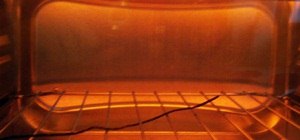 DIY Lab Equipment:
Build Your Own Reflow Oven Out of a Toaster for Precision Temperature Soldering
DIY Lab Equipment:
Build Your Own Reflow Oven Out of a Toaster for Precision Temperature Soldering
-
 How To:
DIY Rocket Propellant! How to Cook Solid Rocket Fuels Using Common Household Ingredients
How To:
DIY Rocket Propellant! How to Cook Solid Rocket Fuels Using Common Household Ingredients
-
 Spice Rack Explosives:
How to Make Gunpowder with Salt & Sugar
Spice Rack Explosives:
How to Make Gunpowder with Salt & Sugar
-
 How To:
Make a Hydrogen Fireball from Aluminum Foil and Toilet Bowl Cleaner
How To:
Make a Hydrogen Fireball from Aluminum Foil and Toilet Bowl Cleaner
-
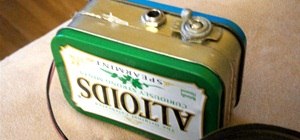 How To:
Build Your Own Mini Altoids Guitar Amp for About $5
How To:
Build Your Own Mini Altoids Guitar Amp for About $5
-
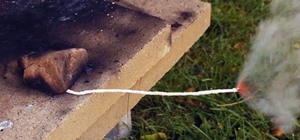 How To:
Make Slow Burning Fuses from Yarn, Sugar, & Potassium Nitrate
How To:
Make Slow Burning Fuses from Yarn, Sugar, & Potassium Nitrate
-
 How To:
Turn a Microwave Oven Transformer into a High Amperage Metal Melter!
How To:
Turn a Microwave Oven Transformer into a High Amperage Metal Melter!
-
 How To:
Build a Long Range Laser Spy System for Eavesdropping on Your Neighbors
How To:
Build a Long Range Laser Spy System for Eavesdropping on Your Neighbors
-
 News:
DIY Arduino Battery Tester Reveals the Secret Capacity of Disposable Batteries
News:
DIY Arduino Battery Tester Reveals the Secret Capacity of Disposable Batteries
-
 How To:
Make Solid Rocket Fuel at Home with Old Newspapers
How To:
Make Solid Rocket Fuel at Home with Old Newspapers
-
 DIY Blacksmithing:
Forge Your Own Steel at Home!
DIY Blacksmithing:
Forge Your Own Steel at Home!
-
 How To:
Make a Mini Flamethrower, Exploding Fireball, & Flint Bomb Sparkler with Disposable Lighters
How To:
Make a Mini Flamethrower, Exploding Fireball, & Flint Bomb Sparkler with Disposable Lighters
-
 How To:
Create Practically Anything, Part 1: Fritzing Circuit Boards
How To:
Create Practically Anything, Part 1: Fritzing Circuit Boards
-
 How To:
Create Your Own Cast and Oogoo to Give Your DIY Gadgets the Shape You Want
How To:
Create Your Own Cast and Oogoo to Give Your DIY Gadgets the Shape You Want
-
 DIY Polygraph Machine:
Detect Lies with Tin Foil, Wire and Arduino
DIY Polygraph Machine:
Detect Lies with Tin Foil, Wire and Arduino
-
 The Sweet Smell of Success:
DIY Smoke Mix with Sugar and Potassium Nitrate
The Sweet Smell of Success:
DIY Smoke Mix with Sugar and Potassium Nitrate
-
 How To:
Make Your Own "TV-B-Gone" to Silence All Televisions That Oppose You
How To:
Make Your Own "TV-B-Gone" to Silence All Televisions That Oppose You
-
 Fire Texting:
How to Write Secret Messages with Fire
Fire Texting:
How to Write Secret Messages with Fire
-
 How To:
Melt Metal with a Modified Microwave Oven Transformer
How To:
Melt Metal with a Modified Microwave Oven Transformer
-
 How To:
See-Through DIY Rocket Engine Lets You Watch Fuel Combustion in Action
How To:
See-Through DIY Rocket Engine Lets You Watch Fuel Combustion in Action



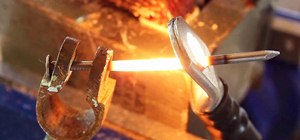

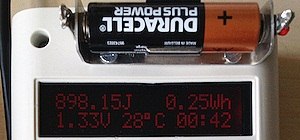

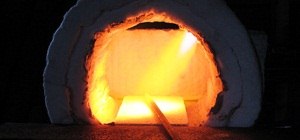
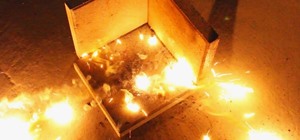



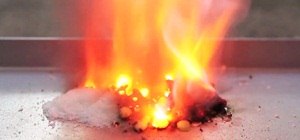
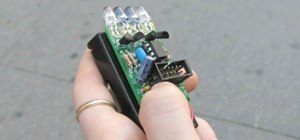


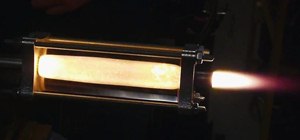
23 Responses
Question:
Has anyone out there made a successful sugar rocket? If so, do you have any hunches about our failed design in the first article?
If you haven't yet, please do some research on the Rocket Equation - you can find sources easily. That is THE dominant context within which all rocket engineering needs to develop. Basically, you need your payload to get some given delta-V, to get to some given altitude, to orbit (18,000 MPH) or escape velocity (25,000 MPH). Calculate your needed delta-V for your goal as if you were operating in a vacuum, and then begin to estimate air friction losses (this will be an ongoing process).
The rocket concept is that by pushing some (most!) of the initial mass away at high speed, conservation of momentum will push the rest of the rocket in the other direction - giving it a delta-V or change of velocity. How much delta V you get depends on how fast you push out the lost mass (eg: hot combustion gasses, or ions for an ion engine), and on how much of your mass you can eject. (In the real world it also depends on efficiencies of burning and the shape of your chamber etc; the basic Rocket Equation is the ideal or best case but no rocket nozzle is 100% efficient, etc). Mainly tho, air friction makes real rockets much less efficient than the ideal rocket.
A century ago or so it was realized that there's pretty much no workable chemical reaction which ejects mass fast enough to get a payload into orbit - the math just doesn't support it. (If we had evolved on a planet with the gravity of Luna, it would have been much easier; if it had twice our gravity, getting into space would have been nearly impossible with chemical rockets) The solution for Earth's gravity was multi-stage rockets, where the (smaller) payload of one stage is yet another rocket which (sorta) restarts the equation for the next stage - by discarding as much as possible of the "housing" mass from the earlier stages - at the costs of a still huge multiplier between the payload and the initial rocket size needed, complex control systems, and a lot of wasted equipment.
The entire space program can be seen on the backdrop of the Rocket Equation. Understanding the Rocket Equation is as important to rocketry as understanding Ohm's law is to electronics. I recall talking to a (real) "rocket scientist", designer of some of the first planetary fly-by gravity assist orbits for getting the speed needed to visit outer planets, who said something like "my whole career has consisted of finding partial workarounds to the limitations of the rocket equation".
Unfortunately, the implications turn out to be a bit daunting, which is why it took governments so much of the previous century to successfully develop practical means of getting into orbit or beyond. Unfortunately, while the inherent reducibility of information to tiny physical implementations has made it possible for us to buy cheaply what would once have been a super-computer in power, no such exponential growth has happened in overcoming things limited by the laws of physics and moving matter, like the rocket equation. We do have a real advantage in terms of the core of control systems (the microchip) compared to early rocket pioneers, but the physical limitations of chemical reactions and the rocket equation are still unyielding.
It's easier for amateurs or professionals to get to the edge of space with balloons, and you can find a lot of projects of that sort on the web - balloons don't face the rocket equation, but they have other major limitations obviously! (Starting a rocket from a balloon platform doesn't buy you as much you you might hope, by the way, as their high altitude payloads are also very constrained and you still face most of the earth's gravity well even at top altitude; the main thing they offer is less air friction. You will notice that balloon launched rockets are not a widespread technology even with huge budgets; that's not because it hasn't been considered and tried.
And, without going into space, there is still a lot of challenge in high altitude rocketry. The big common point is that things have to be super light. For example, all the extra unneeded weight of a cell phone is problematic. You probably want a minimal PCB with just the elements you require. Luckily you seem adept that those skills.
Anyway, I hope this is helpful and not too daunting - your interest, intelligence and enthusiasm is great and it WILL yield some good results, whether or not they match the earliest ambitions like space flight per se.
And if you are already well aware of the rocket equation and its implications, consider this just a small intro for your readers, upon which you can build in some future posting.
cant you use your Pulsing Jar Jet Engine to make a rocket??
The liquid methanol is a lot harder to deal with than a solid fuel rocket. Also, if we eventually want it to work in space it will need to contain its own source of oxygen. Jets require oxygen from their surroundings to ignite the jet fuel.
Good thinking though! It is definitely worth experimenting with pulse jet engines for the sake of coolness.
you could always have two sources the first is the pulse jet and when its out of mehanol you could somehow make the second ignite so it is propelled further up
and yeah watching the video it is pretty awesome
Hmmm we should do a comparison of weight to thrust for the two fuels.
if you need any help just ask
what material do you use to make the rocket?
Help would be most welcome! I am trying to bring together a community around Operation Galactic Invasion. I have seen many rockets online made of pvc pipe so that is what I am using right now. Please feel free to make your own rockets and see if we are getting different results!
ill try then :) ill try and look at the best material to use
its a great topic
Awesome! Glad to have you on board with the invasion. Feel free to submit pictures, videos, or write ups to the corkboard so we can all learn from each other and not repeat mistakes.
Hello there, i think you got an awersome proyect and wanna make it seen become true :D but you are missing a few things like aerodinamics or the right material to build it, i recomend you to see this http://www.sockshare.com/file/79C825CAE29227E4 on that episode they tried more or less the same thing, it can bring you some ideas
Wow! Thanks so much for the video link Eric! I never would have thought of using rubber or pvc as rocket fuel. Nitric oxide seems overly dangerous but good to know its an option.
Thanks for being part of the galactic invasion team! Hope to talk with you about the next rocket project!
You're welcome, of course i'll be following you, like i've said before this its a great idea :D i want to see a galactic invasion!
by the way, i was forgotting to tell you something, one of the reasons that i was sending the video it becouse i dont think that a potassium and powdered sugar based fuel really could be able to actually leave earths gravity or get in orbit even with the help of an hydrogen ballon to rise his hight, at much it will elevate a few miles on the sky and if you put a camera you will see the curvature of the earth but that its gonna be all, the reason of this its that more than altitud ( that helps ) its velocity, the name of this its escape volocity and its a veery large number, you need above 25300 mph, for that reason i think it would be better if you can try with more powerfull fluels
Excellent idea! I will stick with the sugar rocket fuel until I have the basics of tracking, parachute deployment, and aerodynamics down. After that is all well and good it seems that more power is definitely in order!
good, i got an idea for the traking, you could use a celphone with gps, it wont work at hight altitud becouse of the government restrictions ( so you cant use gps to launch nukes all over the world XD, weard but true... ) , but when it start to land it will appear in the maps, adicionally put some leds in the rocket so if you can not find it on day, in night it will become easy to find
Good idea! I wonder if we could use the accelerometer in the phone too! Anyone have experience with data logging and communication using a cell phone?
hello there, well since no one its answering i got the time to look a little bit for that, i didnt find too much but i find that there already aplications that meassure the velocity and acceleration of the cell phone, so it depends which one you will use
cool! Thanks Eric. Have you found anything for android phones?
there you got it http://es.androidzoom.com/android_applications/tools/accelerometer-explorer_jqjw.html
Hey Guys,
This is an incredibly interesting discussion.
I myself have been extremely in love with rocketry since my first B engine estes rocket my dad got me one day when I was home from school back in the day.
Anyways, I have not made a rocket in a long time, life kicked in, work etc etc so yeah. I really want to get back into the game at some stage and now seems like as good a time as any. I already have a partial build which I started 8 or so months ago created from fibreglass (my father has been building a plane for the past 18 years so I have lots of fibreglass at hand).
With the discussion on flight computers and the recent article on the arduino lie detector, there are MANY plugins for the arduino boards that would suit flight computers, this including gps units, accelerometer units etc etc.
This would be a much cheaper and relatively more accurate alternative to a mobile phone running on android or what not.
Anyways I look forward to where this thread goes.
thanks,
Kyle.
On a more concrete level, rather than an Arduino board you might look to using bare ATMegas (as you already do), or if you want a platform, look a the Teensy or a clone Arduino Pro Mini which you can get on eBay delivered for around $10, a bit more for 328). Much smaller/lighter and somewhat cheaper with the same computing power. You can get them without the header pins and solder wires to the PCB holes.
Thanks for all the info Zeph!!
Share Your Thoughts